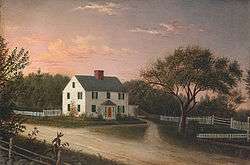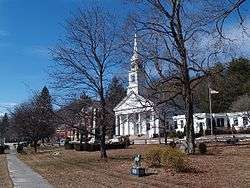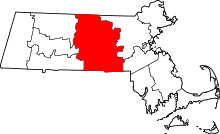Sterling, Massachusetts
| Sterling, Massachusetts | ||
|---|---|---|
| Town | ||
|
Sterling Town Common | ||
| ||
 Location in Worcester County and the state of Massachusetts. | ||
| Coordinates: 42°26′15″N 71°45′40″W / 42.43750°N 71.76111°WCoordinates: 42°26′15″N 71°45′40″W / 42.43750°N 71.76111°W | ||
| Country | United States | |
| State | Massachusetts | |
| County | Worcester | |
| Settled | 1720 | |
| Incorporated | 1781 | |
| Government | ||
| • Type | Open town meeting | |
| • Town Administrator | Michael Szlosek | |
| • Board of Selectmen |
Richard Lane John Kilcoyne Maureen Cranson | |
| Area | ||
| • Total | 31.6 sq mi (81.8 km2) | |
| • Land | 30.5 sq mi (79.0 km2) | |
| • Water | 1.1 sq mi (2.8 km2) | |
| Elevation | 502 ft (153 m) | |
| Population (2010) | ||
| • Total | 7,808 | |
| • Density | 250/sq mi (95/km2) | |
| Time zone | Eastern (UTC-5) | |
| • Summer (DST) | Eastern (UTC-4) | |
| ZIP code | 01564 | |
| Area code(s) | 351 / 978 | |
| FIPS code | 25-67385 | |
| GNIS feature ID | 0619490 | |
| Website | www.sterling-ma.gov | |
Sterling is a town in Worcester County, Massachusetts, USA. The population was 7,808 at the 2010 census.
History
Sterling was first settled by Europeans in 1720 and was officially incorporated in 1781.
Previous to its incorporation it was "the Second Parish of Lancaster," and was commonly called by a portion of its Indian name, Chocksett.[1] The original Indian name of the area being Woonsechocksett. The land encompassing the Chocksett region was not originally included in the first land sold by the great Indian Chief Sholan to the settlers of the Lancaster grant. However, Sholan's nephew Tahanto would eventually sell the Chocksett land to inhabitants of Lancaster in 1713.
The first white settlers arrived in Chocksett seven years later in 1720, formerly inhabitants of Lancaster proper.[2] Among these first settlers were families such as Beman, Sawyer, Houghton, and Osgood; names reflected to this day in the names of Sterling's oldest roads.[3]
A short time after settlement, in 1733, the residents of the Chocksett area requested its own incorporation, separate from Lancaster, due to the "great inconvenience" of a long distance to the church in Lancaster's center. This request was denied. However, by 1780 the population of Chocksett was so numerous as to constitute a majority, and so the voters of the area voted out the existing Lancaster town officers and began to conduct town business and meetings in Chocksett. This was enough to convince the rest of Lancaster that it was now time for Chocksett, the Second Parish of Lancaster, to go its own way.[4]
In 1781, Chocksett was incorporated as its own town: Sterling. The town derives its name from General William "Lord Stirling" Alexander, a Scottish expatriate, who served valiantly under Gen. George Washington in the New York and other campaigns. His portrait hangs in the town hall, and the town commemorated Alexander with a medallion during its bicentennial celebration in 1976. A duplicate portrait resides in the town hall of New Windsor, NY.
Residents recently approved and built new facilities for the police and fire departments. The town enjoys a low crime rate even though it has large metropolitan areas both north and south of its borders.
Geography
According to the United States Census Bureau, the town has a total area of 31.6 square miles (82 km2), of which 30.5 square miles (79 km2) is land and 1.1 square miles (2.8 km2), or 3.42%, is water.
Interstate 190 cuts Sterling in half. Sterling is also crossed by Massachusetts Route 12, Massachusetts Route 62, Massachusetts Route 140, and Massachusetts Route 110.
Sterling is bordered by Leominster to the north, West Boylston to the south, Princeton and Holden to the west, Lancaster to the northeast, and Clinton and Boylston to the southeast. Sterling borders Boylston on the Wachusett Reservoir.
Demographics
| Historical population | ||
|---|---|---|
| Year | Pop. | ±% |
| 1850 | 1,805 | — |
| 1860 | 1,881 | +4.2% |
| 1870 | 1,670 | −11.2% |
| 1880 | 1,414 | −15.3% |
| 1890 | 1,244 | −12.0% |
| 1900 | 1,420 | +14.1% |
| 1910 | 1,359 | −4.3% |
| 1920 | 1,305 | −4.0% |
| 1930 | 1,502 | +15.1% |
| 1940 | 1,713 | +14.0% |
| 1950 | 2,166 | +26.4% |
| 1960 | 3,193 | +47.4% |
| 1970 | 4,247 | +33.0% |
| 1980 | 5,440 | +28.1% |
| 1990 | 6,481 | +19.1% |
| 2000 | 7,257 | +12.0% |
| 2010 | 7,808 | +7.6% |
| * = population estimate. Source: United States Census records and Population Estimates Program data.[5][6][7][8][9][10][11][12][13][14] | ||

As of the census[15] of 2000, there were 7,257 people, 2,573 households, and 2,068 families residing in the town. The population density was 237.7 people per square mile (91.8/km²). There were 2,637 housing units at an average density of 86.4 per square mile (33.4/km²). The racial makeup of the town was 98.06% White, 0.58% African American, 0.10% Native American, 0.40% Asian, 0.01% Pacific Islander, 0.28% from other races, and 0.58% from two or more races. Hispanic or Latino of any race were 0.81% of the population.
There were 2,573 households out of which 39.9% had children under the age of 18 living with them, 69.8% were married couples living together, 7.3% had a female householder with no husband present, and 19.6% were non-families. 15.3% of all households were made up of individuals and 6.1% had someone living alone who was 65 years of age or older. The average household size was 2.82 and the average family size was 3.16.
In the town the population was spread out with 27.5% under the age of 18, 5.6% from 18 to 24, 30.7% from 25 to 44, 27.1% from 45 to 64, and 9.0% who were 65 years of age or older. The median age was 38 years. For every 100 females there were 99.1 males. For every 100 females age 18 and over, there were 95.1 males.
The median income for a household in the town was $67,188, and the median income for a family was $76,943. Males had a median income of $51,227 versus $32,734 for females. The per capita income for the town was $28,844. About 1.7% of families and 2.9% of the population were below the poverty line, including 4.5% of those under age 18 and 5.7% of those age 65 or over.
Government
| County-level state agency heads | |
|---|---|
| Clerk of Courts: | Dennis P. McManus (D) |
| District Attorney: | Joseph D. Early, Jr. (D) |
| Register of Deeds: | Anthony J. Vigliotti (D) |
| Register of Probate: | Stephanie K. Fattman (R) |
| County Sheriff: | Lew Evangelidis (R) |
| State government | |
| State Representative(s): | Kimberly Ferguson (R), Harold P. Naughton, Jr. (D) |
| State Senator(s): | Jennifer L. Flanagan (D) |
| Governor's Councilor(s): | Jennie L. Caissie (R) |
| Federal government | |
| U.S. Representative(s): | James P. McGovern (D-2nd District), |
| U.S. Senators: | Elizabeth Warren (D), Ed Markey (D) |

Taxes
The tax rate in Sterling has remained fairly steady over recent years and has occasionally been reduced by a small percentage. These small decreases however have been dramatically overshadowed by extreme increases in house evaluations resulting in many residents effectively paying 50–75% more in taxes in 2005 as compared with five years earlier.
The Waushacum Village Homeowner's Association, however, being a private neighborhood southeast of the Sterling Junction, employs a system in which the land is leased from the neighborhood committee, which creates low house valuations in the area.
The Waushacum Village Homeowner's Association is also the only neighborhood in Sterling that operates a unified sewage and waste management system.

Library
The Sterling public library began in 1871.[16][17] In fiscal year 2008, the town of Sterling spent 1.59% ($289,567) of its budget on its public library—some $36 per person.[18] The Library Building closed in 2002 so it could be renovated. During this time, the library was temporarily moved to the Old Town Hall. The renovation was finished in 2004, and the library returned to its original location.
Education
Sterling is part of the Wachusett Regional School District. Students between Grades K-4 attend Houghton Elementary School while students between Grades 5-8 attend Chocksett Middle School. The schools were named after the Native American tribes that once occupied the area. Most Sterling residents attend Wachusett Regional High School in Holden for high school. Some Sterling residents however can attend Montachusett Regional Vocational Technical School in Fitchburg.
Private Schools
- Applewild School, established in 1957, - a private, independent co-educational day school for grades Preschool - 8th grade located in Fitchburg, MA.
Utilities
Sterling provides town water to many residents although the more rural parts of town remain on private wells. The quality of the town water is high after the installation of a purification system. The water is drawn from a private underground spring which flows from the Chickopee Water Table. In the early 2000s town water supply was affected by high bacteria levels and residents were forced to boil water for three weeks until the situation was resolved. With the exception of the Waushacum Home Owner's Association (whose residents enjoy a private purification system) there are no town sewer services - all houses have private septic systems.
The town also offers curbside trash and recycling pickup for no additional fee. The town recycling center at the Sterling Department of Public Works closed permanently on July 1, 2015.[19] Residents may use the Wachusett Watershed Regional Recycling Center in West Boylston, MA to drop off recycling and larger bulk items.
Sterling is one of 38 or so communities in the state that has its own municipal electric light company that is separate from other municipal government functions. Sterling ratepayers are the owners of this utility and reap the benefits of exceptional service and an early payment discount on their monthly bills. The Light Dept works under the direction and control of three elected Commissioners who serve rotating 3 year terms. The Light Board hires a Manager who runs day-to-day operations. In May 2013, the Light Board began the process of expanding to establish a Municipal Gas Company to bring natural gas service to town.
Points of interest
An annual event, the Sterling Fair, is a popular place to be in early to mid-September. The Sterling Fair is a 2 1/2 day, family oriented, community, agricultural fair with the emphasis on agriculture and education. There is no charge for admission or parking fees. There are carnival games and rides, as well as patron-submitted exhibits and art works, a petting zoo, contests, oxen pulls, a pancake breakfast held by the Sterling Chocksett Club, live music performance, a wide array of food options, and the popular hot air balloon rides.
A close proximity to Wachusett Mountain (state forest and ski area) and Leominster State Forest gives Sterling plenty of outdoor adventure.
Davis Farmland, a seasonal petting zoo for children and Davis Mega Maze, New England's only world class adventure cornfield maze.
Sholan Park located on Lake Waushacum has a beach area with a dock for swimming. It also has grills for cookouts, a sand volleyball court, and a boat ramp.
Notable people
- Ebenezer Butterick (29 May 1826 – 31 March 1903), inventor of tissue paper dress patterns, which revolutionized home sewing. The town's municipal building is located in the old Butterick School, which was named after Ebenezer Butterick's daughter, Mary Ellen.
- Edwin Conant, Businessman, Attorney, Philanthropist.
- Charles Herbert Colvin, aeronautical engineer
- Jay Cutler, bodybuilder and four-time Mr. Olympia
- Prentiss Mellen, United States senator (1818–1820)
- William Francis Nichols, Arizona Territorial Secretary
- Le Gage Pratt, U.S. Representative from New Jersey
- Arthur Prentice Rugg Chief Justice, Massachusetts Supreme Court.
Film and literary references
- The 2001 film Shallow Hal had scenes shot in Sterling.
- Sterling is the setting of Sarah Josepha Hale's famous poem, "Mary Had a Little Lamb". Mary Sawyer, the subject of the historically true poem, lived in Sterling. The Sawyer's house was destroyed by arson in August 2007. A new replica of the house has been created.
References
- ↑ Records of the Court of general sessions of the peace for the county of Worcester, Massachusetts, from 1731 to 1737
- ↑ History of Worcester County, Massachusetts, Abijah Perkins Marvin, 1879
- ↑ Topographical and historical sketches of the town of Lancaster, in the commonwealth of Massachusetts: furnished for the Worcester magazine and historical journal (1826)p. 47
- ↑ Topographical and historical sketches of the town of Lancaster, in the commonwealth of Massachusetts: furnished for the Worcester magazine and historical journal (1826) p. 56
- ↑ "TOTAL POPULATION (P1), 2010 Census Summary File 1". American FactFinder, All County Subdivisions within Massachusetts. United States Census Bureau. 2010.
- ↑ "Massachusetts by Place and County Subdivision - GCT-T1. Population Estimates". United States Census Bureau. Retrieved July 12, 2011.
- ↑ "1990 Census of Population, General Population Characteristics: Massachusetts" (PDF). US Census Bureau. December 1990. Table 76: General Characteristics of Persons, Households, and Families: 1990. 1990 CP-1-23. Retrieved July 12, 2011.
- ↑ "1980 Census of the Population, Number of Inhabitants: Massachusetts" (PDF). US Census Bureau. December 1981. Table 4. Populations of County Subdivisions: 1960 to 1980. PC80-1-A23. Retrieved July 12, 2011.
- ↑ "1950 Census of Population" (PDF). Bureau of the Census. 1952. Section 6, Pages 21-10 and 21-11, Massachusetts Table 6. Population of Counties by Minor Civil Divisions: 1930 to 1950. Retrieved July 12, 2011.
- ↑ "1920 Census of Population" (PDF). Bureau of the Census. Number of Inhabitants, by Counties and Minor Civil Divisions. Pages 21-5 through 21-7. Massachusetts Table 2. Population of Counties by Minor Civil Divisions: 1920, 1910, and 1920. Retrieved July 12, 2011.
- ↑ "1890 Census of the Population" (PDF). Department of the Interior, Census Office. Pages 179 through 182. Massachusetts Table 5. Population of States and Territories by Minor Civil Divisions: 1880 and 1890. Retrieved July 12, 2011.
- ↑ "1870 Census of the Population" (PDF). Department of the Interior, Census Office. 1872. Pages 217 through 220. Table IX. Population of Minor Civil Divisions, &c. Massachusetts. Retrieved July 12, 2011.
- ↑ "1860 Census" (PDF). Department of the Interior, Census Office. 1864. Pages 220 through 226. State of Massachusetts Table No. 3. Populations of Cities, Towns, &c. Retrieved July 12, 2011.
- ↑ "1850 Census" (PDF). Department of the Interior, Census Office. 1854. Pages 338 through 393. Populations of Cities, Towns, &c. Retrieved July 12, 2011.
- ↑ "American FactFinder". United States Census Bureau. Retrieved 2008-01-31.
- ↑ C.B. Tillinghast. The free public libraries of Massachusetts. 1st Report of the Free Public Library Commission of Massachusetts. Boston: Wright & Potter, 1891. Google books
- ↑ Conant Public Library. Retrieved 2010-11-10
- ↑ July 1, 2007 through June 30, 2008; cf. The FY2008 Municipal Pie: What’s Your Share? Commonwealth of Massachusetts, Board of Library Commissioners. Boston: 2009. Available: Municipal Pie Reports. Retrieved 2010-08-04
- ↑ "Drop Off Recycling Center | Sterling MA". www.sterling-ma.gov. Retrieved 2016-02-13.
External links
| Wikimedia Commons has media related to Sterling, Massachusetts. |
- Sterling official website
- Sterling Historical Society official website
- History of Sterling Massachusetts: Images, photos and postcards from the past


